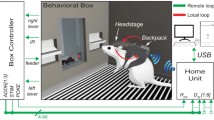Abstract
A system for supplying power to implanted electronic circuits by means of an electromagnetic field has been developed and tested in chronic experiments with monkeys (Macaca Mulatta and Macaca Fascicularis), freely moving and interacting with each other. The transferred energy is used by electronic circuits which drive a number of telemetric multi-injectors within a headmounted container. The system makes use of batteries redundant. Besides saving space within the container this technique circumvents periodic changes of batteries, which is very important in long-term experiments, where disturbance of the social behaviour under study has to be reduced as far as possible.
Sommaire
Un système pour fournir l'énergie aux circuits électroniques implantés grâce à un champ électromagnétique a été mis au point et testé au cours d'expériences chroniques sur des singes (Macaca Mulatta et Macaca Fascicularis) se déplaçant sans entraves et agissant l'un sur l'autre. L'énergie transférée est utilisée par des circuits électroniques qui commandent un certain nombre d'injecteurs télémétriques multiples contenus dans un petit boîtier fixé sur la tête. Le système permet de se passer de piles. En plus de l'économie de volume dans le boîtier, cette technique évite les changements périodiques de piles, ce qui est très important dans les expériences à long terme pour lesquelles tout dérangement du comportement social étudié peut être évité autant que possible. Le champ électromagnétique n'est présent que durant les stimulations ou mesures réelles.
Zusammenfassung
Ein System zur Netzversorgung eingepflanzter Elektonikschaltkreise über ein elektromagnetisches Feld wurde konstruiert und in chronischen Experimenten mit sich freibewegenden und miteinander spielenden Affen (Macaca Mulatta und Macaca Fascicularis) getestet. Die übertragene Energie wird von Elektronikschaltkreisen verbraucht, die eine Reihe von telemetrischen Multi-Injektoren antreiben, die in einem am Kopf angebrachten Behälter untergebracht sind. Durch dieses System wird der Gebrauch von Batterien hinfällig. Außer der Platzeinsparung innerhalb des Behälters, wird durch dieses System das periodische Auswechseln von Batterien vermieden. Dieses ist bei Langzeitexperimenten besonders wichtig, da hierbei Störungen des sozialen Verhaltens während der Studien soweit wie möglich reduziert werden müssen. Das elektomagnetische Feld ist nur während der eigentlichen Stimulation oder den Messungen eingeschaltet.
Similar content being viewed by others
References
Cools, A. R., Lagerwey, C., Lambrechts, P., andvan Rossum, J. M. (1975) Chemistor: a re-usable telestimulation device for direct chemical stimulation of the non-human primate brain in freely moving animals,Physiol. & Behav. 14, 229–233.
Cools, A. R. andvan den Bercken, J. H. L. (1977) Cerebral organization of behaviour and the neostriatal function. In: Psychobiology and the striatum, 119–140. (Eds. A. R. Cools, A. H. M. Lohman and J. H. L. van den Bercken). Elsevier/North Holland, Amsterdam.
Ko, Wen H. andHynecek, J. (1974) Implant evaluation of a nuclear power source-Betacel battery,IEEE Trans. BME 21, 238–241.
Lagerwey, C. (1975) ‘Chemistor’, een draadloos bedienbaar microinjectiesysteem geschikt voor het geven van injecties in de hersenen van apen,Mikroniek,15, 60–63.
Author information
Authors and Affiliations
Rights and permissions
About this article
Cite this article
Cools, A.R., Lambrechts, P. & van Bommel, J. Wireless power-supplying system for implanted electronic circuits in freely moving animals. Med. Biol. Eng. Comput. 16, 559–563 (1978). https://doi.org/10.1007/BF02457809
Received:
Accepted:
Issue Date:
DOI: https://doi.org/10.1007/BF02457809




